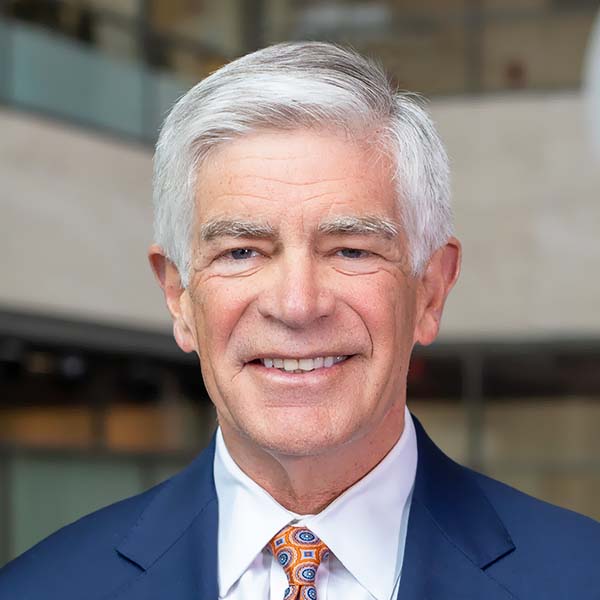Good evening and thank you for being here tonight. It is always a pleasure to be back at the University of Pennsylvania. I have spent 30 years of my career on college campuses, and nothing matches their innovation and knowledge creation anywhere.
I am happy to cross paths again with Susan Wachter, codirector of the Penn Institute for Urban Research and a former colleague of mine at the Wharton School. Susan is the coeditor of the book we are here to discuss tonight, Shared Prosperity in America’s Communities. The book is an example of the great work Penn IUR continues to do to bring attention ― and solutions ― to issues that have an impact on urban areas.
I would also like to recognize the contributions to this book that the Community Development Studies & Education team has made. This includes Dr. Lei Ding, who served as the book’s co-editor.
Shared Prosperity in America’s Communities is an impressive collection of essays from respected researchers and thinkers that explores the intersection of inequality and place. This is the fourth in a series of books that the Federal Reserve Bank of Philadelphia and Penn IUR have published together. These volumes stem from our joint biennial conference, Reinventing Our Communities. Each conference ― and accompanying book ― highlights the issues that have an impact on older industrial communities.
I can’t think of a more important or timely topic for communities than inequality and social mobility. I am so pleased that this was both the focus of our 2014 Reinventing conference and tonight’s book.
As reflected by Fed Chair Janet Yellen, economic inequality has long been of interest to the Fed. Chair Yellen has expressed a desire to engage in more research on community development topics, including factors that influence economic mobility.
As the president of the Federal Reserve Bank of Philadelphia, I fully support her interest in increasing our focus here. And as one of my own goals, I hope the dialogue on such topics continues to happen often. I believe tonight’s book helps bridge a gap that is part of the larger conversation on issues including social mobility, economic inclusion, and equitable growth.
Since joining the Fed, I have had the opportunity to see some of these issues play out in communities throughout our District. This has been through conversations with community leaders who we have met at the Fed and through tours of the District. And what I have learned from these experiences reflects many of the themes in the Shared Prosperity book and the topics of tonight’s discussion.
Shared Prosperity in America’s Communities provides important insights on the intersection of geography and opportunity. This helps us understand the cost of inequality. And that cost is great.
Raj Chetty, one of the book’s contributors, suggests that a child born into the bottom quintile of income distribution, has a 7.5 percent chance of reaching the top quintile in the United States. He says, “Improving opportunities for children from disadvantaged families to succeed should be a priority for policy makers not just because it is one of the core principles of American society but also because improving mobility can have substantial economic payoffs.”
I agree with Raj. It’s not only in the name of justice and fairness that we should focus on this topic. It’s also because this is an economically smart thing to do. These issues are of particular importance here in the City of Philadelphia, given the demographics that I am sure you are all familiar with today.
Despite signs of economic growth and progress, Philadelphia is still the second-poorest large city in America, with a poverty rate of 26.5 percent, according to the latest U.S. Census figures. Philadelphia also has the highest deep poverty rate of the nation’s 10 most populous cities.
While Philadelphia has experienced recent job growth, the rate of growth has been slower than other U.S. cities. Also, the jobs are predominantly low wage and perpetuate ― rather than reverse ― the cycle of poverty.
We are lucky to have two of the book’s authors here tonight:
- Elizabeth Kneebone, a fellow at the Metropolitan Policy Program at the Brookings Institution, and
- Paul Jargowsky, a professor of public policy and the director of the Center for Urban Research and Education at Rutgers University–Camden.
We also have two leaders in attendance from our local community who will discuss the implications of inequality for the City of Philadelphia. They are:
- Eva Gladstein, the deputy managing director of health and human services for the City of Philadelphia, and
- Laura Sparks, the executive director of the William Penn Foundation.
As I approach policy decisions, it is discussions such as the one tonight that help me best represent the Third District in Washington, D.C. The topics, research, and personal stories add a human element to the data I review each day.
That said, it is important to have forums where research can inform practice and practice can inform research. This book is an illustration of that approach, and I hope we can continue working together.
Thank you for joining us here tonight and for your continued efforts to achieve economic growth and stability in our region.
I will now hand the discussion over to Theresa Singleton, vice president of Community Development Studies & Education Department at the Fed and the moderator for tonight’s conversation.
Note: The views expressed are my own and not necessarily those of the Federal Reserve System or the FOMC.
View the Full Speech

